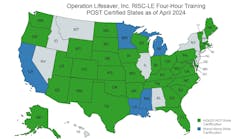Virtually every day in America, an automated external defibrillator (AED) enables someone with little or no medical training to save the life of another human being afflicted by sudden cardiac arrest (SCA). This fact makes SCA unique among other leading causes of death such as heart attack, stroke and cancer – afflictions requiring interventions from medical professionals.
Yet, SCA survival rates have remained around only eight percent for the past 30 years, according to one of the studies referenced in “Sudden Cardiac Arrest – Everyone is a Potential Lifesaver,” an article by Defibtech vice president Greg Slusser published in the August 2012 issue of Facility Safety Management magazine.
SCA survival remains at 8 percent of 380,000 annual victims in America primarily because they do not receive shocks quickly enough from an AED. Slusser writes: “This 8 percent survival rate is dismal, especially when compared to the roughly 85 percent survival rate of heart attack victims.” He explains the difference between SCA – an arrhythmic disorder that can be treated with an AED – and a heart attack – a blocked artery that must be cleared or bypassed in a medical facility.
Advances in AED technology have made bystanders who witness SCA events into primary lifesavers. Their involvement improves survival rates significantly, according to scientific studies.
Providing bystanders with easy-to-use AEDs is essential toward improving the SCA survival rate. AEDs are approaching a tipping point similar to when smart phones became easy to use and preferred by most consumers. The Defibtech Lifeline VIEW™ AED merges audio, video, training and maintenance capabilities into an easy-to-use lifesaving device that inspires confidence in the minds of potential rescuers, Slusser states.



